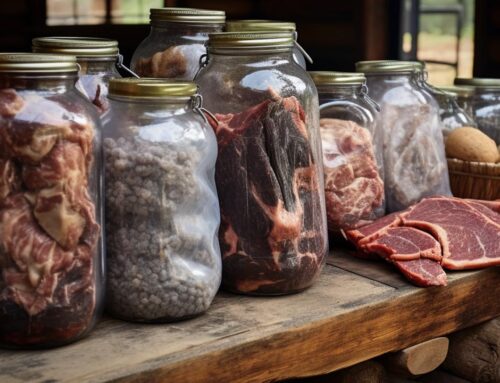Foraging for a Forest Delicacy – the Chanterelle
Chanterelles, nature’s own gourmet offering nestled in the forest, are a delight for foragers and foodies alike. These vibrant mushrooms, with their golden hues and enchanting shapes, beckon from beneath the forest canopy, promising a delicate flavor that has captivated chefs and home cooks. As we embark on this journey to uncover the secrets of chanterelle foraging, let’s step into the verdant realms where these treasures reside.
Table of Contents
- Characteristics of Chanterelles
- Identifying Chanterelles
- Chanterelle Lookalikes
- Habitat and Growth Patterns
- Seasonality
- Foraging Tips and Techniques
- Harvesting Chanterelles
- Cleaning and Storing Chanterelles
- Cooking with Chanterelles
- Health Benefits of Chanterelles
- FAQs
- Conclusion
- Additional Resources

Characteristics of Chanterelles
Resplendent in Color and Form
Basking in shades of yellow and orange, chanterelles are known for their striking presence against the forest floor. Their funnel-shaped caps, with wavy and irregular edges, range from 1 to 6 inches in diameter, making them unmistakable. The stipe, or stem, is robust and tapers slightly towards the base, adding to their distinguished appearance.
Gills Like No Other
Unlike typical mushrooms, chanterelles boast blunt, forked ridges, often lighter than the cap. These false gills run down the stem, a key identifier for this species.
An Aroma of the Wild
Their fruity, apricot-like smell is not just a delight but also a crucial identification marker. This pleasant aroma sets them apart from potential look-alikes, ensuring foragers can distinguish them with confidence.

Identifying Chanterelles
A Gold Standard in Mushroom Identification
Identification is paramount when foraging for chanterelles. Their size, ranging from 2-4 inches tall, and color, from light yellow to dark golden yellow-orange, are initial indicators. As they mature, they often take on a vase-like or funnel shape with a noticeable center indent, although some retain a flatter shape. The fleshy, non-hollow stem, sharing the cap’s color, and the dense, white or pale yellow flesh are critical identifiers.
Fruity Fragrance as a Foraging Tool
Chanterelles emit a faint yet distinct fruity scent, akin to apricots. This olfactory clue is especially pronounced when encountering a large cluster, adding another dimension to the foraging experience.
Chanterelle Lookalikes
The Art of Differentiation
Foraging is not without its challenges, and among these are the chanterelle lookalikes, such as the Jack-O-Lantern and False Chanterelles. While similar in color, these deceptive mushrooms can be distinguished by their true, sharp gills, and in the case of Jack-O-Lanterns, their growth in clusters on wood.
Habitat and Growth Patterns
The Chanterelle’s Chosen Realm
Chanterelles show a preference for hardwood or mixed forests, often accompanying oak, beech, birch, or coniferous trees. They thrive in well-drained, slightly acidic soil rich in organic matter, a testament to their discerning taste for high-quality environments.

Seasonality
A Season for Foraging
Chanterelles make their grand debut between late spring and early fall, with the season varying based on climate. In temperate regions, their season may extend from June through October, while in colder areas, it’s more restricted to late summer and early fall.
Foraging Tips and Techniques
Beginner’s Guide to the Chanterelle Chase
For those new to the world of foraging, the journey begins with education. Investing in guidebooks tailored to your region, such as “Mushrooms of the Redwood Coast” or “California Mushrooms: The Comprehensive Identification Guide”, is invaluable. Remember, if there’s any doubt about a mushroom’s identity, it’s best left untouched.
Ethical Foraging: A Sustainable Approach
Foraging isn’t just about the harvest; it’s about respecting nature. Leave some mushrooms behind to maintain the ecosystem, and be gentle with the surrounding environment. Always obtain permission before foraging on private lands and steer clear of protected areas.
An Excellent Video Covering Foraging and Cooking
Harvesting Chanterelles
Harvesting with Care
When you stumble upon a trove of chanterelles, remember to harvest responsibly. Cutting the stem rather than plucking ensures minimal damage to the mycelium and promotes future growth. Assess each mushroom for freshness and avoid those showing signs of decay or insect damage.
Cleaning and Storing Chanterelles
Keeping Your Bounty Fresh
Cleaning chanterelles is a delicate task. A light rinse or a gentle brush is often all that’s needed. Store them in a paper bag in the fridge, ideally using them within a week for optimal freshness. For longer storage, consider drying or sautéing and freezing the mushrooms.

Cooking with Chanterelles
Unlocking the Culinary Potential
Chanterelles are culinary chameleons, blending beautifully into a variety of dishes. Their delicate flavor shines through in simple sautés with butter and garlic, while their texture adds depth to soups, stews, and risottos. For a gourmet touch, incorporate chanterelles into your breakfast omelets or quiches.

Health Benefits of Chanterelles
A Treasure Trove of Nutrients
Beyond their taste, chanterelles offer a wealth of health benefits. They’re a source of vitamins, particularly vitamin D and C, and minerals like potassium and copper. Their antioxidant properties and potential anti-inflammatory effects make them a valuable addition to a healthy diet.

Frequently Asked Questions
Conclusion
As we conclude our exploration of chanterelle foraging, it’s clear that these forest delicacies offer more than just a culinary delight. They are a journey into the heart of nature, an exercise in mindful harvesting, and a gateway to a world of flavors and health benefits. Whether you’re a seasoned forager or a curious newcomer, the chanterelle mushroom is a forest gem worth seeking.










Leave A Comment